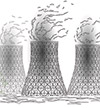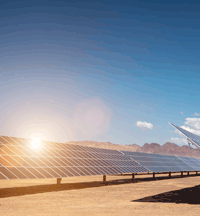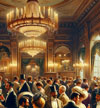Industry in the Era of the Electron
Growth of the digital economy has put transmission-adjacent properties and the ability to interconnect at the forefront of the site selection process.
Q1 2024

A digital renaissance has now ballooned across industrial and commercial segments. A measure of market potential for clean energy component and advanced technology manufacturers, access to electricity has materialized as a dominant location determinant in the corporate site selection process. Along the backbone of the nation’s power grid is an expanded chessboard of energy prospectors posturing for control of power-intensive industrial real estate.
Reborn
Today, in pursuit of business capabilities forged only by data and advanced analytics, the bridge between digital possibilities and industrial realities is built with electrons. Electricity consumption required to scale cloud-based technologies is challenging transmission capacity in parts of the country, complicating project timelines following a significant surge in manufacturing construction. While today’s contenders for power are not new, they are reborn — each attempting to solve for headwinds that require additional quantities of power. Among the motivators pushing industrial occupiers toward higher levels of consumption are a concurrent shift in consumer habits and desire for digital goods and services, labor force constraints including a shortage of skilled workers, the continued ascension of e-commerce, carbon emission targets, mounting overhead costs, and the rise of AI and cloud computing. Along the backbone of the nation’s power grid is an expanded chessboard of energy prospectors posturing for control of power-intensive industrial real estate.
Simultaneously, federal legislation introducing tax credits and incentives strengthened the business case for large investments within energy-intensive industries. These pervasive conditions have created a fresh environment for competition among different real estate classes, as transmission-adjacent properties across the country swarm with interested parties of all segments and sizes. Semiconductor fabrication plants, electric vehicle and grid-scale battery manufacturers, data centers, solar panel producers, along with other sectors emboldened by private equity and tax credits, race to secure real estate along these high-voltage corridors — electron superhighways that connect the U.S. through nearly 160,000 miles of line.
Positioning for scalability in a crowded field, manufacturers commercializing innovative technologies move expeditiously through the site selection process, often without the abundance of historical data to forecast facility loads. Navigating these considerations while defending against a trailing competitive position, models sometimes rely on inflated power demands to hedge against operating constraints or extrapolate data from pilot plants testing new production technologies. Fluctuating production targets, along with innovations in manufacturing technologies and process design, add to the complexity of these projects and further cloud the variance between usage prediction and meter readings.
One thing, however, is clear. The digital economy that we are quickly building suggests that transmission-adjacent real estate, and moreover the ability to interconnect, will continue to be at the forefront of the site selection process.
Industries in Perspective
Accelerated by shifting U.S. work habits, a switch to cloud-based technologies, and the use of AI, data center growth is soaring. Data centers now consider consolidation, growth in nontraditional markets, and investments into energy storage and generation as methods to rise above challenges related to the cost of capital, supply chain constraints, and issues with transmission-level interconnections. Energy density requirements to support processing power are hitting record levels, with “hyperscale” developers sometimes requiring peak demands between 500–1,000 megawatts (MW), approaching the generating capacity of a single nuclear reactor.
Federal legislation introducing tax credits and incentives strengthened the business case for large investments within energy-intensive industries. Driven in part by recent legislation — notably the Inflation Reduction Act and Chips and Science Act — electric-vehicle, battery, and semiconductor projects have also raced to the grid. The U.S. Treasury reports that $100 billion in private-sector investment has been announced across the clean vehicle and battery supply chain. Electrode, cell, module and packs, and other battery grade components manufacturing have inundated power-rich sites across the automotive belt and beyond. Similarly, semiconductor announcements have swallowed large chunks of generating capacity in some U.S. markets, as larger fabrication campuses approaching full buildout can require a peak demand upwards of 1,200 MW.
Warehouse and distribution centers are lowering operating costs, reducing maintenance, and supporting sustainability goals by automating operations and adopting electric fleets. A large distribution center combined with an electric short-haul fleet needs upwards of 15 MW at peak demand. Another way to look at the transportation sector’s potential impact on a single circuit — 50 Class 8 trucks/tractor trailers require approximately nine MW of peak demand availability, equal to that of New York City’s Empire State Building.
The buildout of refrigerated storage is another critical and more capital-intensive component to warehousing and logistics. However, the U.S. has struggled to keep up with e-commerce’s Covid-induced home-cooking and grocery shopping trends, despite millions of square feet of temperature-controlled storage space being added in recent years. On average, refrigerated warehouses consume upwards of 25 kilowatt-hours (kWh) of electricity per square foot. This puts the average 100,000-square-foot cold storage facility at a peak demand of 3.5 MW, equivalent to the needs of approximately 1,700 households.
The steady advance of intelligent technologies and electrification will further etch power’s footing within industrial real estate strategy. Endgame
The steady advance of intelligent technologies and electrification will further etch power’s footing within industrial real estate strategy. While grid modernization, investments supporting greater transmission and generation capacities, and the commercialization of advanced energy systems will ultimately allow for much of this electrification to occur in concert, recent pressures placed by historically large U.S. economic development announcements will continue to reverberate through 2024. Risk mitigation, the essence of site selection, has never demanded a higher degree of collaboration. Certainly, electric service delivery and scalability still need to be managed along with other pressing considerations including water availability, labor demands, supply chain modeling, and other real estate criteria. Industrial occupiers of all sizes should heed the utility-first and all-of-the-above approach to site selection.
Project Announcements
First Solar Plans Gaffney, South Carolina, Operations
11/15/2025
Norway-Based Vianode Plans St. Thomas, Ontario, Canada, Operations
11/14/2025
Ireland-Based CEL Critical Power Plans James City County, Virginia, Manufacturing Operations
11/13/2025
Aclara Resources Plans Calcasieu Parish, Louisiana, Heavy Rare Earth Separation Operations
11/04/2025
Eos Energy Enterprises Expands Allegheny County, Pennsylvania, Operations
11/01/2025
Germany-Based Becker Mining Systems Plans Mount Vernon, Ohio, Manufacturing Operations
10/18/2025
Most Read
-
The Workforce Bottleneck in America’s Manufacturing Revival
Q4 2025
-
Rethinking Local Governments Through Consolidation and Choice
Q3 2025
-
First Person: Filter King’s Expansion Playbook
Q3 2025
-
Lead with Facts, Land the Deal
Q3 2025
-
How Canada Stays Competitive
Q3 2025
-
America’s Aerospace Reboot
Q3 2025
-
Investors Seek Shelter in Food-Focused Real Estate
Q3 2025



